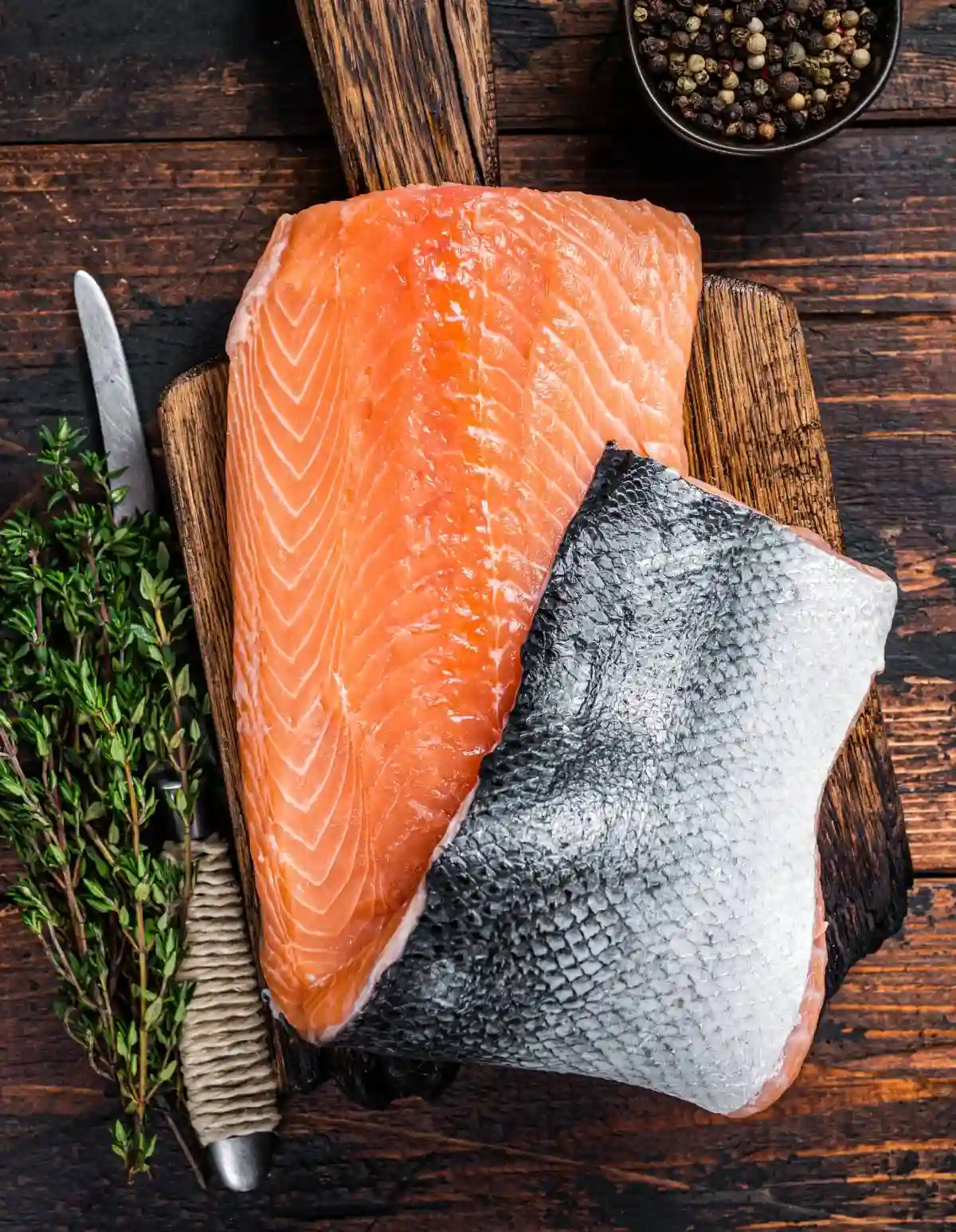Salmon, a name that often paints a vivid picture of vibrant hues in our minds, encompasses far more than just a single color. This magnificent creature, celebrated both in the wild and on our plates, carries a palette that tells tales of nature, nurture, and the nuances of nutrition. Within the scales of salmon, we find a spectrum that spans from soft, pale pinks to deep, mesmerizing oranges. But what lies behind these captivating colors? Well, buckle up, as we’re about to dive into the fascinating world of the colour of salmon, unraveling the mysteries that give this fish its unique tint and the remarkable journey from riverbeds to our dinner tables.

Introduction
The color of salmon isn’t just a feast for the eyes; it’s a gateway to understanding a host of ecological, biological, and cultural stories. From the wild streams where salmon hatch to the vast oceans they traverse, every aspect of their journey influences their iconic coloration. Farmed or wild, the hue of salmon flesh has become a symbol of health, a marker of quality, and a subject of scientific curiosity. Through the lens of salmon’s color, we explore the interconnectedness of ecosystems, the impact of human practices on marine life, and the cultural significance of this beloved fish across the globe.
Part 1: The Natural Shades of Salmon
When you picture salmon, what color comes to mind? Is it the soft pink of a dawn sky, or perhaps the rich orange of a setting sun? The truth is, the natural shades of salmon are as diverse as the environments they inhabit and the species themselves. Let’s cast our nets wider and explore the vibrant world of salmon colors in the wild.
Variations in Wild Salmon
In the wild, salmon’s color is a testament to their lifestyle and diet. The pigments called carotenoids, particularly astaxanthin, play a crucial role here. Astaxanthin, a powerful antioxidant, is found in the krill and plankton that make up the salmon’s diet. The more astaxanthin they consume, the more intense the color. Wild salmon, therefore, display a range of colors based on their specific diet and the richness of carotenoids in their natural habitat.
Impact of Habitat on Colour
But it’s not just diet that colors our finned friends; their habitat plays a pivotal role too. Salmon that traverse the cold, nutrient-rich waters of the North Pacific absorb different levels of pigmentation compared to those in warmer or less bountiful waters. The pristine, icy streams and rivers where salmon spawn and mature also contribute to the development of their unique hues.
This interplay between diet and habitat highlights the salmon’s remarkable adaptability and the delicate balance of marine ecosystems. As we delve deeper into the colour of salmon, we begin to appreciate not just the beauty of this fish but also the complexity of its existence and the importance of preserving its natural habitats. For a deeper dive into the significance of these habitats, the National Oceanic and Atmospheric Administration offers a wealth of information on salmon ecosystems and conservation efforts.
Stay tuned as we navigate further into the world of salmon coloration, exploring how human practices and scientific interventions are painting a new picture of this age-old marvel.
Salmon Colour in Aquaculture
Aquaculture, the practice of raising fish in controlled environments, has painted a new shade on the colour of salmon. Unlike their wild cousins, farmed salmon are fed a diet meticulously designed to mimic the natural pigments found in their oceanic buffet. This segment of our journey explores how science and sustenance interweave to influence the color palette of farmed salmon.
Diet and Colour Enhancement
In the world of aquaculture, the diet plays a starring role in the salmon’s coloration. Farmed salmon are often fed pellets that contain synthetic astaxanthin or canthaxanthin, which are carotenoids used to replicate the vibrant hues found in wild salmon. This dietary intervention is crucial; without it, farmed salmon would sport a less appealing, paler shade. The science behind this diet is fascinating, blending nutritional needs with consumer expectations. It’s a delicate dance of biology and market demands, ensuring that the salmon not only thrive but also meet the visual and nutritional standards consumers have come to expect.
Consumer Perception and Market Value
The colour of salmon on our plates does more than just please the eye; it influences our perception of quality and freshness. Market research has shown that consumers lean towards salmon with vibrant, deep hues, associating these colors with health, taste, and premium quality. This consumer behavior drives the aquaculture industry to prioritize coloration in their breeding and feeding practices, showcasing the direct link between the salmon’s hue and its market value.
Aquaculture’s role in maintaining the salmon’s iconic color while ensuring sustainability presents a colorful conundrum. It raises questions about authenticity, environmental impact, and the future of fish farming. As the industry continues to evolve, it must balance these factors, striving to produce healthy, appealing salmon without compromising the integrity of our oceans. For insights into sustainable salmon farming practices, the Aquaculture Stewardship Council www.asc-aqua.org is an invaluable resource, offering standards and certifications that guide responsible aquaculture.
With our plates filled with knowledge about the farmed salmon’s hues, our exploration doesn’t stop here. The science behind the salmon’s coloration beckons us further, inviting us to delve into the genetic and environmental factors that sculpt the palette of this fascinating fish. Stay hooked, as the next part of our journey unveils the mysteries beneath the surface.
The Science Behind Salmon Colour
Diving deeper into the colour of salmon, we now explore the scientific undercurrents that shape this fascinating feature. Beyond diet and habitat, genetics and environmental factors play crucial roles in determining the salmon’s hues. This segment unravels the intricate dance of nature and nurture that culminates in the salmon’s vibrant palette.
Pigmentation and Genetics
The genetic makeup of salmon is like a blueprint for their coloration. Specific genes dictate the ability of salmon to absorb and metabolize carotenoids, the pigments responsible for their rich colors. This genetic variation means that even within the same species, individual salmon can exhibit a range of colors based on their genetic predisposition to process and store these pigments.
Moreover, selective breeding in aquaculture has allowed scientists and farmers to emphasize traits that enhance coloration, alongside health and growth rates. This genetic tinkering not only satisfies market demands for visually appealing salmon but also sheds light on the genetic mechanisms controlling pigmentation, offering insights into the evolutionary paths of different salmon species.
Environmental Factors
The environment in which salmon live is a canvas that influences their coloration. Temperature, stress levels, and water quality all interact with genetics to paint the final color of a salmon. For instance, cooler water temperatures have been linked to more efficient absorption of carotenoids, leading to richer colors.
Stress, whether from changes in water conditions, competition, or handling, can affect the salmon’s metabolism, including how it processes pigments. Similarly, the purity and composition of water can impact the availability and absorption of natural pigments in wild salmon, subtly shading their coloration.
The interplay between genetics and the environment in determining the colour of salmon underscores the complexity of this trait. It’s a vivid reminder of the adaptability of salmon to their ever-changing worlds, both in the wild and in aquaculture settings. Understanding these factors not only fascinates the curious mind but also guides sustainable practices in salmon farming and conservation efforts.
As we swim through the depths of salmon coloration science, we are reminded of the myriad factors that contribute to the beauty of these creatures. Their color tells a story of evolution, adaptation, and human influence, inviting us to reflect on our role in preserving the natural tapestry of life. For those interested in the genetic factors affecting salmon colour and other quality characteristics, Scientific Research on Salmon Colouration offers a deep dive into the latest studies and findings.
Our journey through the colour of salmon now turns towards its conclusion, where we’ll reflect on the cultural significance of salmon color and its impact on our dining experiences and environmental consciousness.
FAQs on the Colour of Salmon
As we navigate the final currents of our exploration into the colour of salmon, it’s clear this topic is as deep and varied as the oceans these majestic creatures inhabit. Common questions often bubble to the surface, reflecting widespread curiosity and the desire for deeper understanding. Let’s tackle some of these frequently asked questions, shedding light on popular inquiries.
Why do wild and farmed salmon have different colours?
The primary difference in colour between wild and farmed salmon stems from their diets. Wild salmon feast on a natural diet rich in carotenoids, particularly astaxanthin, from eating krill and small fish. This diet bestows them with their vibrant colour. Farmed salmon, meanwhile, are fed a controlled diet that includes carotenoid supplements to mimic the natural pigmentation process. Though the end result is visually similar, the sources of their colouration differ markedly.
Can the colour of salmon indicate its quality or nutritional value?
While the colour of salmon is not a direct indicator of nutritional value, it does influence consumer perceptions of quality and freshness. A rich, vibrant colour is often associated with a healthy, nutrient-rich fish. However, nutritional content, such as omega-3 fatty acids, is consistent across salmon of various colours, provided they are healthy and well-fed.
Is the colouring added to farmed salmon safe to eat?
Yes, the carotenoids used in farmed salmon feed, like astaxanthin, are approved for use and deemed safe by regulatory agencies worldwide. Astaxanthin is a potent antioxidant found naturally in marine ecosystems and is identical to the synthetic version added to salmon feed. Its use in aquaculture is carefully regulated to ensure consumer safety and health.
How does the environment affect the colour of wild salmon?
Environmental factors such as water temperature, purity, and the salmon’s specific habitat significantly influence their colouration. Cooler waters can enhance the absorption of natural pigments, while cleaner, less polluted waters support a diet that leads to richer colours. Additionally, the physical demands of navigating their habitats can impact muscle composition and colour. What temperature and length to cook salmon?
Conclusion and Recommendations
The journey through the colour of salmon reveals a tapestry woven with threads of biology, ecology, and human influence. This vibrant hue serves not only as a visual delight but as a marker of the health and vitality of both the fish and its environment. It underscores the importance of sustainable practices in both wild habitats and aquaculture to preserve the natural beauty and biodiversity of our planet. How long to bake salmon at 400
As consumers, we play a pivotal role in this ecosystem. Opting for sustainably sourced salmon, whether wild or farmed, supports practices that preserve our waterways and ensure the health of salmon populations for generations to come. Furthermore, educating ourselves about the origins and practices behind our seafood choices fosters a deeper connection to the natural world and our place within it.
In closing, the colour of salmon is a reminder of the interconnectedness of all things. It invites us to ponder our impact on the natural world and to act with mindfulness and respect for the delicate balance that sustains life on our blue planet. As we continue to enjoy the bounty of the sea, let us also commit to being stewards of its unparalleled beauty and diversity.


